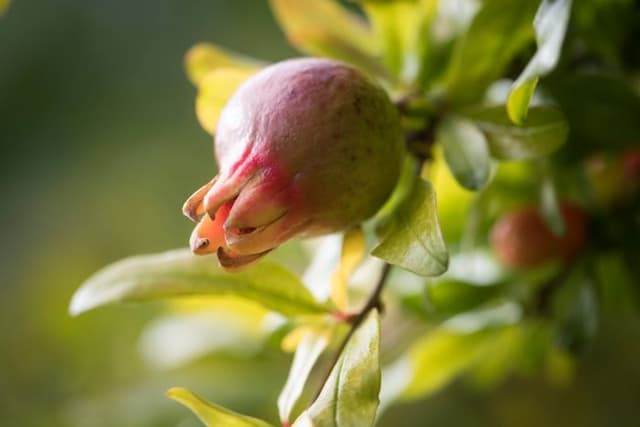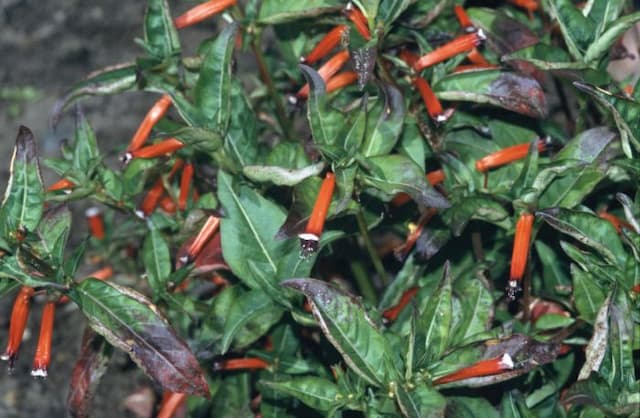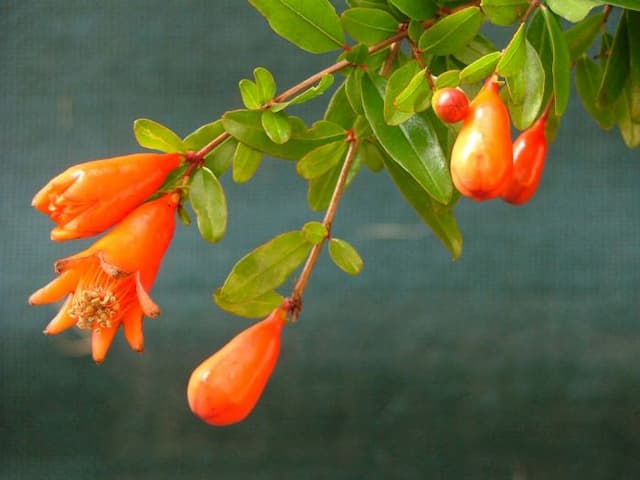Purple loosestrife Lythrum salicaria 'Robert'

ABOUT
Lythrum salicaria 'Robert', commonly known as Purple loosestrife 'Robert', is a herbaceous perennial that showcases a striking appearance. From summer to early autumn, it produces tall spikes adorned with vibrant pinkish-purple flowers, which are rich in nectar and attract plenty of pollinators like bees and butterflies. The individual flowers are small, star-shaped and densely packed around the spike, giving it a fluffy, elongated appearance. The foliage of 'Robert' is lance-shaped, with a smooth texture and a lush green color that adds a pleasant contrast to the bright floral display. This cultivar can be a point of visual interest in ornamental gardens due to its vivid blooms and strong vertical form, which can bring structure and color to borders and waterside plantings.
About this plant
 Names
NamesSynonyms
Purple Loosestrife, Rosy Strife, Spiked Loosestrife, Purple Lythrum, Rainbow Weed.
Common names
Lythrum salicaria.
 Toxicity
ToxicityTo humans
Purple loosestrife is generally not considered toxic to humans. There are no well-documented cases of poisoning from ingesting Purple loosestrife, and it doesn't typically pose a risk if touched or ingested in small quantities. However, caution should always be exercised as individual reactions to plants can vary, and it is not recommended to consume parts of ornamental plants without expert guidance.
To pets
Purple loosestrife is also generally not considered toxic to pets. There is no significant evidence to suggest that this plant poses a toxicity risk to animals like dogs and cats. While it is always best to prevent pets from ingesting plants unnecessarily, Purple loosestrife does not typically produce symptoms of poisoning in pets. Nevertheless, individual animals might react differently, and monitoring for any unusual behavior after ingestion is advisable.
 Characteristics
CharacteristicsLife cycle
Perennials
Foliage type
Deciduous
Color of leaves
Green
Flower color
Pink
Height
3-4 feet (0.9-1.2 meters)
Spread
2-3 feet (0.6-0.9 meters)
Plant type
Herb
Hardiness zones
4
Native area
Europe
Benefits
 General Benefits
General Benefits- Attracts Pollinators: Lythrum salicaria 'Robert' is popular among bees, butterflies, and other beneficial insects, thus promoting biodiversity.
- Aesthetic Appeal: With its vibrant purple-pink flowers, it adds color and visual interest to gardens and landscapes.
- Erosion Control: Its root system helps stabilize soil, especially in wet areas, reducing erosion.
- Wildlife Habitat: Provides shelter and nourishment for various species of wildlife, particularly birds.
- Water Tolerance: Being a wetland plant, it is well-suited for waterside plantings and bog gardens.
- Easy Cultivation: It is a hardy plant that requires minimal care once established, making it suitable for low-maintenance gardens.
 Medical Properties
Medical Properties- This plant is not used for medical purposes.
 Air-purifying Qualities
Air-purifying QualitiesThis plant is not specifically known for air purifying qualities.
 Other Uses
Other Uses- Purple loosestrife 'Robert' can be used for dyeing fabrics, where different parts of the plant can yield different shades such as greens and yellows.
- The plant can be incorporated into floral arrangements for its showy spikes of purple flowers, which can add height and color to bouquets.
- Can be used as a teaching tool in ecology and conservation classes to demonstrate the impact of invasive species on local ecosystems.
- In some areas, the stems of purple loosestrife have been used in traditional basket weaving and crafting due to their strong and flexible nature.
- Focused planting of Lythrum salicaria 'Robert' can be utilized in research to study its competition with native species and the resulting impacts on biodiversity.
- When managed properly, this plant can serve as a controlled habitat for certain species of butterflies and moths that use it as a food source.
- Photographers and artists may utilize the striking appearance of purple loosestrife 'Robert' as a subject or backdrop for artistic projects.
- Due to its rapid growth and dense structure, it can be used to help control erosion on banks of streams and rivers where invasive spread is not a concern.
- The tall, dense growth of purple loosestrife can provide privacy screening in garden designs when used thoughtfully.
- It can be used in controlled scientific experiments to understand the mechanisms of allelopathy, where plants release chemicals that affect the growth of surrounding plant life.
Interesting Facts
 Feng Shui
Feng ShuiPurple loosestrife is not used in Feng Shui practice.
 Zodiac Sign Compitability
Zodiac Sign CompitabilityPurple loosestrife is not used in astrology practice.
 Plant Symbolism
Plant Symbolism- Persistence: Lythrum salicaria, commonly known as "Purple Loosestrife," is a hardy plant that can thrive in various environments, symbolizing the ability to persist through challenges.
- Strength: Due to its robust growth and tendency to dominate landscapes, Purple Loosestrife represents strength and domination over obstacles.
- Beauty in solitude: As a plant that stands out because of its tall spikes of purple flowers, it can represent the idea of finding beauty and strength in solitude or in standing alone.
- Struggle and Conquest: Since Purple Loosestrife is considered an invasive species in many regions, it can symbolize struggle but also conquest and overcoming limitations.
 Water
WaterPurple loosestrife, commonly known as 'Robert', prefers consistently moist soil and should be watered thoroughly; this could be about 1-2 gallons per week depending on climate conditions. It's crucial to keep the soil moist but not waterlogged. During hot and dry periods, water should be provided more frequently to maintain moisture levels, while in cooler or rainy seasons, you may need to adjust and reduce the watering. Ensure the water penetrates deeply into the soil to encourage a strong root system. Overhead watering is acceptable, but watering at the base of the plant is more efficient and helps prevent leaf diseases.
 Light
LightPurple loosestrife thrives in full sunlight, so 'Robert' should be placed in a location where it can receive at least 6 to 8 hours of direct sunlight per day. It will tolerate partial shade, but flowering may be reduced in less light. Ensure the plant is situated away from taller vegetation that could cast shade and compromise its light requirements.
 Temperature
TemperaturePurple loosestrife is a hardy plant that can withstand a range of temperatures; however, 'Robert' prefers a temperate climate with temperatures ranging from 60 to 75 degrees Fahrenheit for optimal growth. It can survive minimum temperatures down to about -30 degrees Fahrenheit and maximum temperatures up to approximately 85 degrees Fahrenheit, but sustained extremes can stress the plant.
 Pruning
PruningPurple loosestrife benefits from occasional pruning to maintain its shape and encourage vibrant flowering. 'Robert' should be cut back in the late winter or early spring before new growth appears. Deadheading spent flowers during the blooming season can also promote additional blooms. Pruning every year or every other year helps prevent this robust plant from becoming too dense and leggy.
 Cleaning
CleaningAs needed
 Soil
SoilPurple Loosestrife 'Robert' thrives in moist, fertile soil with good organic content. The ideal soil pH for Purple Loosestrife is around 5.5 to 7.5. Amending garden soil with compost and peat moss can help achieve the desired conditions.
 Repotting
RepottingPurple Loosestrife 'Robert' does not require frequent repotting as it is normally grown as a perennial outdoor plant. Repotting can be done every 2-3 years if grown in containers to refresh the soil.
 Humidity & Misting
Humidity & MistingPurple Loosestrife 'Robert' tolerates a wide range of humidity levels and does not require specific humidity conditions to thrive outdoors.
 Suitable locations
Suitable locationsIndoor
Provide full sunlight and moist soil.
Outdoor
Plant in full sun, wet conditions.
Hardiness zone
4-9 USDA
 Life cycle
Life cyclePurple Loosestrife 'Robert' begins its life cycle as a seed that germinates in early spring when temperatures become favorable. The seed develops into a young seedling, which rapidly grows into a robust vegetative state, characterized by a clump of tough, upright stems with lance-shaped leaves. By mid to late summer, the plant reaches maturity and produces spikes of vivid purple flowers that are highly attractive to pollinators. After pollination, the flowers develop into small capsules containing numerous tiny seeds that are dispersed by water, wind, or wildlife. As autumn approaches, the plant's above-ground parts die back, but the root system remains alive to enable the plant to endure winter and resprout in spring. This perennial cycle repeats annually, with the plant potentially expanding its territory each year through both vegetative growth and seed dispersion.
 Propogation
PropogationPropogation time
Summer
Purple loosestrife 'Robert', a cultivar of Lythrum salicaria, can be propagated most effectively through division in the spring. To do this, carefully dig up an established clump and use a sharp spade or knife to divide the root mass into smaller sections, each with several shoots and a good portion of roots. It's important to keep the divisions moist until they are replanted. Plant these divisions at the same depth they were growing previously, spacing them about 12 to 18 inches (approximately 30 to 45 centimeters) apart to allow for ample growth. Water the new plants well and they should establish themselves quickly, bringing the striking purple spires of the Purple loosestrife 'Robert' back to your garden.




